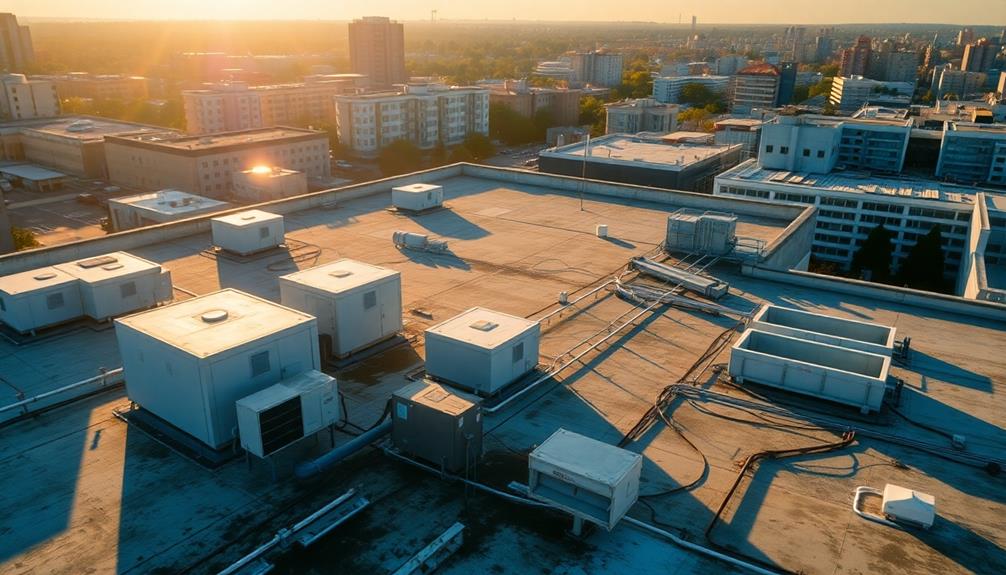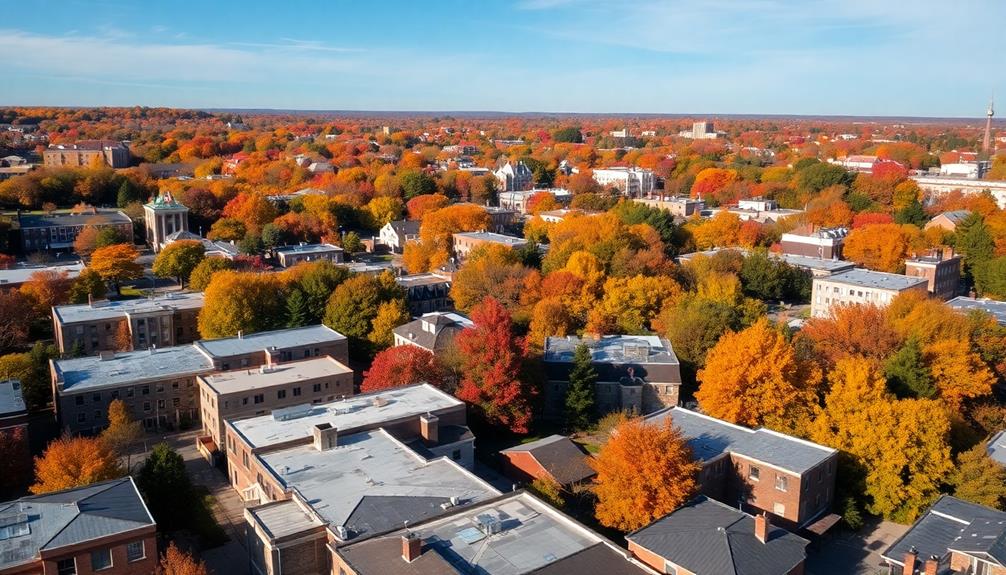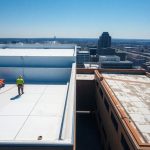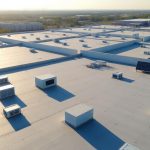Commercial roof inspections are essential for ensuring the structural integrity and durability of roofing systems. Certified inspectors use advanced technology to detect issues such as leaks, membrane damage, and drainage problems early, which prevents costly repairs in the future. These inspections assess environmental impacts, structural load-bearing elements, and material condition, while guaranteeing compliance with safety standards. Detailed inspection reports offer actionable insights and proactive maintenance recommendations that enhance investment longevity. In Colorado, inspections cover various roofing materials and systems, utilizing thermal imaging and visual assessments. Understanding the significance of these inspections can lead to more informed maintenance decisions.
Roofing Highlights
- Commercial roof inspections ensure structural integrity and longevity by detecting issues like leaks and drainage problems early.
- State-of-the-art technology and certified inspectors are employed for detailed evaluations and actionable insights.
- Regular inspections identify potential hazards, including environmental factors and weather impacts, preventing costly repairs.
- These inspections prolong roofing system durability while fostering a safe and secure commercial property environment.
- Scheduling during off-hours minimizes business disruption and may offer cost-effective solutions through seasonal discounts.
Inspection Purpose Explained

At XYZ Roofing Solutions, our commercial roof inspection services are designed to help businesses maintain the structural integrity and longevity of their roofing systems. We specialize in providing affordable, professional solutions for complex roofing needs, guaranteeing that our services accommodate everything from local stores to large-scale properties.
We employ certified roofing inspectors who utilize state-of-the-art technology and adhere to industry standards to meticulously assess every aspect of your roof. By detecting issues such as leaks, membrane damage, or drainage problems early on, our inspections can prevent costly repairs and operational disruptions. Our detailed inspection reports provide actionable insights and tailored recommendations, empowering business owners to make informed decisions about necessary maintenance or replacements.
With a focus on safety, quality, and customer satisfaction, XYZ Roofing Solutions secures your commercial property is well-protected against environmental elements, thereby optimizing your investment.
Identify Potential Hazards
A thorough commercial roof inspection focuses on identifying potential hazards that may compromise the structure's integrity and safety. Potential hazards include environmental factors such as accumulated debris, which can trap moisture and lead to water infiltration and structural damage.
Weather impacts, especially from heavy winds or hail, might cause punctures or tears, necessitating immediate attention to prevent further degradation.
In addition, inspectors prioritize spotting signs of wear on roofing materials, such as cracks, blisters, or separation within the membrane, which could enable leaks and subsequent damage inside the building. Adequately managing these issues early on not only guarantees the roof's longevity but fosters a sense of collective responsibility in maintaining a safe environment for occupants and assets housed beneath.
Furthermore, examining drainage systems for clogs or blockages forms another critical component, as water pooling poses significant threats like surface erosion or even roof collapse. Proper maintenance of these systems directly contributes to effectively mitigating risks.
A commitment to regular roof inspections and proactive hazard identification ensures that possible concerns are addressed promptly, thereby instilling a sense of security and belonging among those working within the structure while upholding professional standards within the organization's operations.
Evaluate Structural Integrity
Determining the structural integrity of a commercial roof is a fundamental objective during inspections, as it directly influences the building's overall safety and longevity. Inspectors meticulously analyze several components to guarantee the roof's foundational parts are sound. They examine load-bearing structures, such as beams and support trusses, to assess their capacity to withstand environmental and operational demands. By evaluating the material conditions, inspectors can identify symptoms of deterioration including rust, corrosion, and wood rot, which pose significant risks to structural health.
Additionally, the inspection process involves scrutinizing the roof's design to ensure it complies with current building codes and safety standards. This includes verifying the roof's slope and drainage capabilities, which are indispensable for effectively channeling water away and reducing the risk of pooling. Such attention to detail prevents undue weight and damage from accumulating over time.
Furthermore, inspectors utilize advanced diagnostic tools, such as infrared scanning and moisture meters, to detect underlying issues not visible to the naked eye. This proactive approach helps identify potential vulnerabilities before they manifest into serious structural concerns. Ultimately, guaranteeing structural integrity builds confidence within the commercial community, fostering a sense of security and belonging among its members.
Prevent Costly Repairs
Through regular inspections, the primary goal of preventing costly repairs is achieved by identifying and addressing potential issues before they escalate. This proactive approach ascertains that commercial building owners and managers maintain the integrity and functionality of their roofing systems without incurring unforeseen expenses.
Routine inspections allow for the early detection of minor defects, such as small leaks or damaged membranes, before they turn into significant structural failures that demand extensive repair efforts and financial investment.
A thorough inspection process involves an all-inclusive assessment of the roof's surface, drainage systems, seams, flashings, and penetrations, which are evaluated for durability, wear, and possible degradation. Trained professionals use advanced diagnostic tools and techniques to pinpoint areas of concern, providing detailed reports and recommendations for corrective action.
By investing in such preventive maintenance, stakeholders foster a sense of security and belonging within their organizations, knowing they are protecting their assets and prioritizing safety for all occupants.
Moreover, addressing potential roofing issues in a timely manner reflects a commitment to sustainability and resource efficiency, thereby enhancing the building's overall value and longevity. Ultimately, preventing costly repairs aligns with responsible facility management practices, ascertaining peace of mind and operational continuity.
Benefits

Commercial roof inspections offer numerous benefits, prominently including early problem detection which can noticeably prolong the longevity and durability of roofing systems. Certified and experienced commercial roofers are well-equipped to identify potential issues before they escalate, allowing businesses to implement cost-effective solutions that not only preserve structural integrity but also reduce long-term maintenance expenses.
Such proactive measures guarantee that commercial properties remain secure and reliable, safeguarding investments and minimizing operational disruptions.
Early Problem Detection
One of the key benefits of early problem detection during commercial roof inspections is the opportunity to address issues before they escalate into major, costly repairs. Identifying vulnerabilities at an early stage enables property managers and owners to proactively implement corrective measures, thereby avoiding potential disruptions to business operations and safeguarding the building's structural integrity. This approach not only guarantees financial prudence by minimizing larger expenses in the long run but also fosters a sense of security among stakeholders who rely on the facility's safety and functionality.
Early detection involves meticulously inspecting various roofing components, such as membranes, flashings, and drainage systems, to spot minute signs of wear and tear. By catching these deficiencies promptly, maintenance teams can swiftly execute repairs or replacements, consequently averting the eventual deterioration that might, if left unchecked, lead to water infiltration or energy efficiency loss. Additionally, routine inspections and timely interventions demonstrate a commitment to excellence, creating a reassuring environment where occupants feel valued and organizations are perceived as responsible custodians of their facilities. Ultimately, the foresight provided by early problem detection nurtures an inclusive community where everyone aligns with the shared objective of preserving the asset's value and functionality.
Longevity and Durability
Effective inspections not only enable early problem detection but also substantially contribute to the longevity and durability of commercial roofs. Regular and thorough inspections are pivotal in maintaining the structural integrity and functional efficacy of roofing systems.
A well-maintained commercial roof withstands environmental stressors such as harsh weather conditions, including heavy precipitation and intense sun exposure, which otherwise accelerate wear and tear. By addressing minor issues before they escalate, inspections extend the lifespan of roofing materials and support systems, reinforcing the building's overall resilience.
Inspections identify potential vulnerabilities, such as compromised flashings or membrane breaches, allowing timely interventions that prevent further deterioration. This proactive approach minimizes the risk of significant structural damage and guarantees the building remains a safe, dry environment.
Efficient maintenance schedules that stem from meticulous roofing evaluations fortify physical structures and enhance the aesthetic appeal of the property, offering a sense of pride and security.
For organizations focused on sustaining their community presence and operational continuity, investing in regular roof inspections signals a commitment to maintaining high standards. This commitment fosters a sense of belonging among stakeholders, knowing that their environment is cared for with diligence and foresight, underscoring their role in a shared, secure future.
Cost-Effective Solutions
Amidst the myriad responsibilities of facility management, focusing on cost-effective solutions for roof maintenance yields considerable financial benefits. A strategic approach to commercial roof inspections not only extends the roof's lifespan but also drastically reduces unforeseen repair costs, fostering a sense of security among stakeholders.
Regular, scheduled inspections allow facility managers to identify minor issues, such as small leaks or drainage problems, before they escalate into costly repairs or require premature replacements.
By employing advanced technologies like infrared scanning and drone surveillance, businesses can accurately map out and address specific problem areas without incurring substantial cost. Such proactive measures guarantee resources are judiciously allocated, thus sidestepping the financial strain of emergency repairs.
Routine maintenance ensures compliance with building regulations and insurance policies, potentially reducing premium costs and enhancing overall asset value.
These strategies create an inclusive sense of reliability and accountability, reinforcing a culture of meticulous care that instills confidence among clients, staff, and partners alike. Ultimately, integrating cost-effective roof maintenance solutions not only preserves a building's structural integrity but also aligns with the broader financial goals of a facility, nurturing its reputation and economic stability in the long term.
Fall Inspection Scheduling Tips

To efficiently schedule commercial roof inspections in the fall, businesses should prioritize safety protocols, ensuring the well-being of both workers and property while taking advantage of business downtime to minimize disruptions in daily operations. Additionally, this period often presents opportunities for capitalizing on seasonal discounts offered by inspection service providers, thereby optimizing budgetary allocations. Below is a structured guide to aid in the planning and execution of these inspections:
| Priority | Consideration | Benefit |
|---|---|---|
| Safety Protocols | Adequate safety measures | Prevent accidents |
| Business Downtime | Minimal operational impact | Reduced interruption |
| Seasonal Discounts | Cost-effective scheduling | Budget optimization |
Prioritize Safety Protocols
As autumn approaches, the importance of prioritizing safety protocols during commercial roof inspections cannot be overstated. Guaranteeing the safety of all personnel involved in these inspections is paramount, not only to protect the individuals on the roof but also to maintain operational integrity and organizational reputation. During the fall season, unpredictable weather conditions such as rain and wind can increase the risk associated with elevated workspaces. Consequently, it is essential to implement thorough safety measures tailored specifically to these environmental conditions.
Professionals involved in conducting roof inspections should be equipped with appropriate personal protective equipment (PPE), including harnesses, helmets, and non-slip footwear. Equally important are training and adherence to regulatory safety standards, which form the bedrock of a secure inspection process.
Clear communication among team members through regular safety briefings and established emergency protocols can drastically mitigate risks. Moreover, utilizing technologies such as drone inspections can minimize the need for direct rooftop presence, further enhancing safety. Implementing detailed checklists to identify potential hazards prior to inspection ensures that no safety aspect is overlooked. By fostering an environment of vigilance and responsibility, organizations can effectively navigate autumn's challenges, underscoring their commitment to safety and collective well-being.
Schedule During Business Downtime
Efficient scheduling is crucial for conducting commercial roof inspections during the fall, as it not only minimizes disruptions to business operations but also guarantees that inspections are completed with precision. Planning inspections during business downtime can be an invaluable strategy for ensuring that operations remain fluid and uninterrupted.
The tranquility of non-peak hours or designated off-days provides the perfect window to address potential roofing issues without impacting the bustling daily activities your business thrives on.
When scheduling inspections in this manner, it is important to collaborate closely with the inspection team to align their availability with your preferred off-hours. This seamless coordination ensures the team's expertise is leveraged at a time that causes minimal inconvenience to employees and clients. Additionally, selecting off-peak periods can allow for a more thorough and meticulous inspection, as the team can operate without the pressure of impending distractions or the hustle and bustle of regular business hours.
Utilize Seasonal Discounts
Scheduling inspections during business downtime offers not only operational advantages but also opens the door to potential cost savings through seasonal discounts. Engaging in fall inspections can be especially beneficial as contractors often provide reduced rates during this period to maintain steady business. This economically strategic scheduling can harness the lower demand post-summer, translating into financial efficiencies for your organization.
By aligning with fall's temperate climate, inspections become more safe and effective, enabling thorough evaluations without the extremes of summer heat or winter cold. This climate consideration not only maximizes contractor availability but also guarantees that maintenance tasks such as cleaning drains, repairing minor damages, and examining waterproofing systems are conducted with precision.
Furthermore, industry partnerships can be leveraged during this less frenetic season. Contractors, mindful of fostering ongoing relationships, often extend loyalty rewards or discounts to clients who commit to recurring services. Such incentives not only embody a sense of community within the industry but also encourage the proactive care of roofing infrastructure. Establishing a routine in fall underscores your commitment to facility management excellence while aligning with cost-efficient practices that benefit both your current operational budget and long-term asset protection.
Connect With Us
Don't leave your commercial property to chance—ensure its safety and longevity with a thorough roof inspection.
Our experienced team is here to provide you with detailed insights into potential storm damages, including hail damage such as dented shingles and cracked roofing vents, and solutions you need.
Connect with us today and safeguard your investment! Call us now at (303) 306-8384 to schedule your inspection or to learn more about our services. Don't wait—protect your property today!
Roofing FAQ
How Often Should a Commercial Roof Be Inspected?
The frequency of roof inspections hinges on various factors including environmental conditions, material type, and building use. Typically, biannual evaluations are recommended to maintain structural integrity and longevity, fostering a safe and welcoming environment for occupants.
What Is the Average Cost of a Commercial Roof Inspection?
Understanding the average cost for professional inspections is essential for fostering community trust in maintenance investments. Typically, costs vary widely, ranging from $200 to $500, contingent on accessibility, roof complexity, and geographic location. Prioritizing regular assessments strengthens collective asset longevity.
Can Inspections Be Conducted During Adverse Weather Conditions?
In adverse weather conditions, inspections can be undertaken with enhanced safety measures, though certain limitations may arise. The integrity of assessments could be affected, demanding rescheduling to guarantee accuracy and thorough evaluation, fostering a reliable and secure community.
Do Inspections Include Checking for Potential Water Damage?
Yes, inspections are thorough, incorporating checks for potential water damage. Identifying early signs of moisture intrusion guarantees timely interventions, consequently fostering an environment of safety and trust while reinforcing the sense of belonging within the community.
How Do I Prepare for a Commercial Roof Inspection?
To prepare for an inspection, guarantee easy roof access, clear debris, and organize documentation of previous maintenance or repairs. Proactive involvement fosters a thorough evaluation, reinforcing your commitment to maintaining a sound and durable structure.



